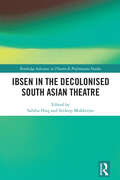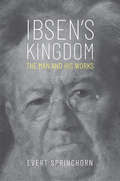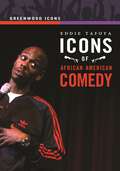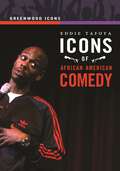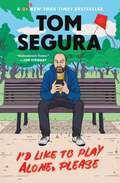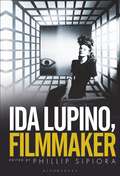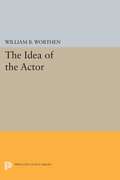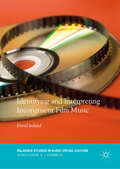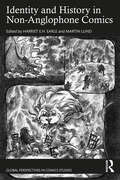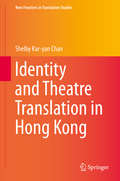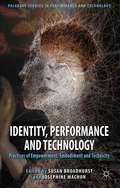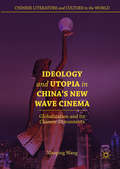- Table View
- List View
Ibsen in the Decolonised South Asian Theatre (Routledge Advances in Theatre & Performance Studies)
by Sabiha Huq Srideep MukherjeeThis book maps South Asian theatre productions that have contextualised Ibsen’s plays to underscore the emergent challenges of postcolonial nation formation. The concerns addressed in this collection include politico-cultural engagements with human rights, economic and environmental issues, and globalisation, all of which have evolved through colonial times and thereafter. This book contemplates why and how these Ibsen texts were repeatedly adapted for the stage and consequently reflects upon the political intent of this appropriative journey of the foreign playwright. This book tracks the unmapped agency that South Asian theatre has acquired through aesthetic appropriation of Ibsen and thereby contributes to his global reception. This collection will be of great interest to students and scholars of theatre and performance studies.
Ibsen in the Decolonised South Asian Theatre (Routledge Advances in Theatre & Performance Studies)
This book maps South Asian theatre productions that have contextualised Ibsen’s plays to underscore the emergent challenges of postcolonial nation formation. The concerns addressed in this collection include politico-cultural engagements with human rights, economic and environmental issues, and globalisation, all of which have evolved through colonial times and thereafter. This book contemplates why and how these Ibsen texts were repeatedly adapted for the stage and consequently reflects upon the political intent of this appropriative journey of the foreign playwright. This book tracks the unmapped agency that South Asian theatre has acquired through aesthetic appropriation of Ibsen and thereby contributes to his global reception. This collection will be of great interest to students and scholars of theatre and performance studies.
Ibsen's Kingdom: The Man and His Works
by Evert SprinchornA major biography of one of the most important figures in modern drama, evoked through a biographical reading of his plays Norwegian playwright Henrik Ibsen achieved unparalleled success in his lifetime and remains one of the most important figures in modern drama. The culmination of a lifetime of scholarship, Evert Sprinchorn’s biography constructs Ibsen’s life through a biographical reading of his plays with provocative and insightful analyses of his works, placing them and their author within the social, political, and intellectual foment of nineteenth-century Europe. This thought-provoking book will captivate anyone interested in the history of drama and the foundations of modernism.
Icons: The Celebrity Exposures of Markus and Indrani
by Markus IndraniMarkus Klinko and Indrani-the hottest team in celebrity and fashion photography-have produced album covers for Beyonce, Mariah Carey, and David Bowie, and shot everyone from Lady Gaga to KateWinslet, Jay-Z, Lindsay Lohan, and Naomi Campbell. As former stars of the Bravo series Double Exposure and in past lives as a recording artist and top model, respectively, Markus and Indrani have spent most of their lives in front of the cameras, giving them a unique perspective on the realities and fantasies of their celebrated subjects. The result is a collection of powerful, definitive, iconic images of some of the most engaging stars of our time.As cutting edge as ever seventeen years into their career, with Icons Markus and Indrani showcase their work for the first time in book form. The text, based on interviews with the photographers and many of the stars they've shot, describes the uniquely fascinating professional partnership of the former lovers, how they work, and tells stories about the famed subjects of their photography-at turns funny, fascinating, and endearing.Filled with more than 250 full-color photographs in crisp detail, Icons is an engrossing showcase of the hottest stars of our day in all their glamorous, glossy, and dynamic perfection. It's a dream package for legions of celebrity followers and photography enthusiasts.
Icons of African American Comedy (Greenwood Icons)
by Eddie M. TafoyaThis in-depth compilation of the lives, works, and contributions of 12 icons of African-American comedy explores their impact on American entertainment and the way America thinks about race.Despite the popularity of comedic superstars like Bill Cosby and Whoopi Goldberg, few books have looked at the work of African-American comedians, especially those who, like Godfrey Cambridge and Moms Mabley, dramatically impacted American humor. Icons of African American Comedy remedies that oversight. Beginning with an introduction that explores the history and impact of black comedians, the book offers in-depth discussions of 12 of the most important African-American comedians of the past 100-plus years: Bert Williams, Moms Mabley, Redd Foxx, Dick Gregory, Flip Wilson, Godfrey Cambridge, Bill Cosby, Richard Pryor, Whoopi Goldberg, Damon Wayans, Chris Rock, and Dave Chappelle. Each essay discusses the comedian's early life and offers an analysis of his or her contributions to American entertainment. Providing a variety of viewpoints on African-American comedy, the book shows how these comedians changed American comedy and American society.
Icons of African American Comedy (Greenwood Icons)
by Eddie M. TafoyaThis in-depth compilation of the lives, works, and contributions of 12 icons of African-American comedy explores their impact on American entertainment and the way America thinks about race.Despite the popularity of comedic superstars like Bill Cosby and Whoopi Goldberg, few books have looked at the work of African-American comedians, especially those who, like Godfrey Cambridge and Moms Mabley, dramatically impacted American humor. Icons of African American Comedy remedies that oversight. Beginning with an introduction that explores the history and impact of black comedians, the book offers in-depth discussions of 12 of the most important African-American comedians of the past 100-plus years: Bert Williams, Moms Mabley, Redd Foxx, Dick Gregory, Flip Wilson, Godfrey Cambridge, Bill Cosby, Richard Pryor, Whoopi Goldberg, Damon Wayans, Chris Rock, and Dave Chappelle. Each essay discusses the comedian's early life and offers an analysis of his or her contributions to American entertainment. Providing a variety of viewpoints on African-American comedy, the book shows how these comedians changed American comedy and American society.
I'd Like to Play Alone, Please: Essays
by Tom SeguraFrom a massively successful stand-up comedian and co-host of chart-topping podcasts &“2 Bears 1 Cave&” and &“Your Mom&’s House,&” hilarious real-life stories of parenting, celebrity encounters, youthful mistakes, misanthropy, and so much more. Tom Segura is known for his twisted takes and irreverent comedic voice. But after a few years of crazy tours and churning out podcasts weekly, all while parenting two young children, he desperately needs a second to himself. It&’s not that he hates his friends and family — he&’s not a monster — he&’s just beat, which is why his son&’s (ruthless) first full sentence, &“I&’d like to play alone, please,&” has since become his mantra. In this collection of stories, Tom combines his signature curmudgeonly humor with a revealing look at some of the ridiculous situations that shaped him and the ludicrous characters who always seem to seek him out. The stories feature hilarious anecdotes about Tom's time on the road, including some surreal encounters with celebrities at airports; his unfiltered South American family; the trials and tribulations of parenting young children with bizarrely morbid interests; and, perhaps most memorably, experiences with his dad who, like any good Baby Boomer father, loves to talk about his bowel movements and share graphic Vietnam stories at inappropriate moments. All of this is enough to make anyone want some peace and quiet. I&’D LIKE TO PLAY ALONE, PLEASE will have readers laughing out loud and nodding in agreement with Segura's message: in a world where everyone is increasingly insane, sometimes you just need to be alone.
Ida Lupino, Filmmaker
by Phillip SipioraIda Lupino, Filmmaker begins with an exploration of biographical studies and analytical treatments of Lupino's film and television work as director, moving forward to assess Lupino's career in film and television with particular attention given to Lupino's singular, pioneering achievements and her role(s) within the cultural milieu(s) of her time, particularly the representation of women in cinema. Each chapter includes a close analysis of the film or television work with insights drawn from film history and cultural/gender studies to demonstrate that Lupino was a significant directorial figure in the development of film, especially in the late 1940s and early 1950s-and in television extending well into the 1960s. Lupino left her imprint on filmmaking and her canon of film and television work continue to influence Hollywood movie making.The contributors to this volume assess Lupino's main strengths as a filmmaker-her treatment of narrative movement, plotting, dialogue, gender roles, and uses of tradition representations of men and women in frames of parody and satire. The book collectively examines the successes (and failures) of Lupino's directorial career, including focusing on the reasons why she initially proved to be so strategic to the progress of women behind the camera.
Ida Lupino, Filmmaker
Ida Lupino, Filmmaker begins with an exploration of biographical studies and analytical treatments of Lupino's film and television work as director, moving forward to assess Lupino's career in film and television with particular attention given to Lupino's singular, pioneering achievements and her role(s) within the cultural milieu(s) of her time, particularly the representation of women in cinema. Each chapter includes a close analysis of the film or television work with insights drawn from film history and cultural/gender studies to demonstrate that Lupino was a significant directorial figure in the development of film, especially in the late 1940s and early 1950s-and in television extending well into the 1960s. Lupino left her imprint on filmmaking and her canon of film and television work continue to influence Hollywood movie making.The contributors to this volume assess Lupino's main strengths as a filmmaker-her treatment of narrative movement, plotting, dialogue, gender roles, and uses of tradition representations of men and women in frames of parody and satire. The book collectively examines the successes (and failures) of Lupino's directorial career, including focusing on the reasons why she initially proved to be so strategic to the progress of women behind the camera.
The Idea of Nature in Disney Animation: From Snow White to WALL-E (Studies in Childhood, 1700 to the Present)
by David WhitleyIn the second edition of The Idea of Nature in Disney Animation, David Whitley updates his 2008 book to reflect recent developments in Disney and Disney-Pixar animation such as the apocalyptic tale of earth's failed ecosystem, WALL-E. As Whitley has shown, and Disney's newest films continue to demonstrate, the messages animated films convey about the natural world are of crucial importance to their child viewers. Beginning with Snow White, Whitley examines a wide range of Disney's feature animations, in which images of wild nature are central to the narrative. He challenges the notion that the sentimentality of the Disney aesthetic, an oft-criticized aspect of such films as Bambi, The Jungle Book, Pocahontas, Beauty and the Beast, and Finding Nemo, necessarily prevents audiences from developing a critical awareness of contested environmental issues. On the contrary, even as the films communicate the central ideologies of the times in which they were produced, they also express the ambiguities and tensions that underlie these dominant values. In distinguishing among the effects produced by each film and revealing the diverse ways in which images of nature are mediated, Whitley urges us towards a more complex interpretation of the classic Disney canon and makes an important contribution to our understanding of the role popular art plays in shaping the emotions and ideas that are central to contemporary experience.
The Idea of Nature in Disney Animation: From Snow White to WALL-E (Studies in Childhood, 1700 to the Present)
by David WhitleyIn the second edition of The Idea of Nature in Disney Animation, David Whitley updates his 2008 book to reflect recent developments in Disney and Disney-Pixar animation such as the apocalyptic tale of earth's failed ecosystem, WALL-E. As Whitley has shown, and Disney's newest films continue to demonstrate, the messages animated films convey about the natural world are of crucial importance to their child viewers. Beginning with Snow White, Whitley examines a wide range of Disney's feature animations, in which images of wild nature are central to the narrative. He challenges the notion that the sentimentality of the Disney aesthetic, an oft-criticized aspect of such films as Bambi, The Jungle Book, Pocahontas, Beauty and the Beast, and Finding Nemo, necessarily prevents audiences from developing a critical awareness of contested environmental issues. On the contrary, even as the films communicate the central ideologies of the times in which they were produced, they also express the ambiguities and tensions that underlie these dominant values. In distinguishing among the effects produced by each film and revealing the diverse ways in which images of nature are mediated, Whitley urges us towards a more complex interpretation of the classic Disney canon and makes an important contribution to our understanding of the role popular art plays in shaping the emotions and ideas that are central to contemporary experience.
The Idea of the Actor
by William B. WorthenAnalyzing the relationship between dramatic action and the controversial art of acting, William Worthen demonstrates that what it means to act, to be an actor, and to communicate through acting embodies both an ethics of acting and a poetics of drama.Originally published in 1984.The Princeton Legacy Library uses the latest print-on-demand technology to again make available previously out-of-print books from the distinguished backlist of Princeton University Press. These editions preserve the original texts of these important books while presenting them in durable paperback and hardcover editions. The goal of the Princeton Legacy Library is to vastly increase access to the rich scholarly heritage found in the thousands of books published by Princeton University Press since its founding in 1905.
The Idea of the Theater in Latin Christian Thought: Augustine to the Fourteenth Century
by Donnalee Dox"Through well-informed and nuanced readings of key documents from the fourth through fourteenth centuries, this book challenges historians' long-held beliefs about how concepts of Greco-Roman theater survived the fall of Rome and the Middle Ages, and contributed to the dramatic triumphs of the Renaissance. Dox's work is a significant contribution to the history of ideas that will change forever the standard narrative of the birth and development of theatrical activity in medieval Europe." ---Margaret Knapp, Arizona State University "...an elegantly concise survey of the way classical notions of theater have been interpreted in the Latin Middle Ages. Dox convincingly demonstrates that far from there being a single 'medieval' attitude towards theater, there was in fact much debate about how theater could be understood to function within Christian tradition, even in the so-called 'dark ages' of Western culture. This book makes an innovative contribution to studies of the history of the theater, seen in terms of the history of ideas, rather than of practice." ---Constant Mews, Director, Centre for the Study of Religion & Theology, University of Monash, Australia "In the centuries between St. Augustine and Bartholomew of Bruges, Christian thought gradually moved from a brusque rejection of classical theater to a progressively nuanced and positive assessment of its value. In this lucidly written study, Donnalee Dox adds an important facet to our understanding of the Christian reaction to, and adaptation of, classical culture in the centuries between the Church Fathers and the rediscovery of Aristotle." ---Philipp W. Rosemann, University of Dallas This book considers medieval texts that deal with ancient theater as documents of Latin Christianity's intellectual history. As an exercise in medieval historiography, this study also examines biases in modern scholarship that seek links between these texts and performance practices. The effort to bring these texts together and place them in their intellectual contexts reveals a much more nuanced and contested discourse on Greco-Roman theater and medieval theatrical practice than has been acknowledged. The book is arranged chronologically and shows the medieval foundations for the Early Modern integration of dramatic theory and theatrical performance. The Idea of the Theater in Latin Christian Thought will be of interest to theater historians, intellectual historians, and those who work on points of contact between the European Middle Ages and Renaissance. The broad range of documents discussed (liturgical treatises, scholastic commentaries, philosophical tracts, and letters spanning many centuries) renders individual chapters useful to philosophers, aestheticians, and liturgists as well as to historians and historiographers. For theater historians, this study offers an alternative reading of familiar texts which may alter our understanding of the emergence of dramatic and theatrical traditions in the West. Because theater is rarely considered as a component of intellectual projects in the Middle Ages, this study opens a new topic in the writing of medieval intellectual history.
Identifying and Interpreting Incongruent Film Music (Palgrave Studies in Audio-Visual Culture)
by David IrelandThis book explores the concept of incongruent film music, challenging the idea that this label only describes music that is inappropriate or misfitting for a film’s images and narrative. Defining incongruence as a lack of shared properties in the audiovisual relationship, this study examines various types of incongruence between a film and its music and considers the active role that it can play in the construction of a film’s meaning and influencing audience response. Synthesising findings from research in the psychology of music in multimedia, as well as from ideas sourced in semiotics, film music, and poststructuralist theory, this interdisciplinary book provides a holistic perspective that reflects the complexity of moments of film-music incongruence. With case studies including well-known films such as Gladiator and The Shawshank Redemption, this book combines scene analysis and empirical audience reception tests to emphasise the subjectivity, context-dependency, and multi-dimensionality inherent in identifying and interpreting incongruent film music.
Identity and History in Non-Anglophone Comics (Global Perspectives in Comics Studies)
by Harriet E.H. Earle and Martin LundThis book explores the historical and cultural significance of comics in languages other than English, examining the geographic and linguistic spheres which these comics inhabit and their contributions to comic studies and academia. The volume brings together texts across a wide range of genres, styles, and geographic locations, including the Netherlands, Colombia, Greece, Mexico, Poland, Finland, Portugal, Ireland, and the Czech Republic, among others. These works have remained out of reach for speakers of languages other than the original and do not receive the scholarly attention they deserve due to their lack of English translations. This book highlights the richness and diversity these works add to the corpus of comic art and comic studies that Anglophone comics scholars can access to broaden the collective perspective of the field and forge links across regions, genres, and comic traditions. Part of the Global Perspectives in Comics Studies series, this volume spans continents and languages. It will be of interest to researchers and students of comics studies, literature, cultural studies, popular culture, art and design, illustration, history, film studies, and sociology.
Identity and History in Non-Anglophone Comics (Global Perspectives in Comics Studies)
This book explores the historical and cultural significance of comics in languages other than English, examining the geographic and linguistic spheres which these comics inhabit and their contributions to comic studies and academia. The volume brings together texts across a wide range of genres, styles, and geographic locations, including the Netherlands, Colombia, Greece, Mexico, Poland, Finland, Portugal, Ireland, and the Czech Republic, among others. These works have remained out of reach for speakers of languages other than the original and do not receive the scholarly attention they deserve due to their lack of English translations. This book highlights the richness and diversity these works add to the corpus of comic art and comic studies that Anglophone comics scholars can access to broaden the collective perspective of the field and forge links across regions, genres, and comic traditions. Part of the Global Perspectives in Comics Studies series, this volume spans continents and languages. It will be of interest to researchers and students of comics studies, literature, cultural studies, popular culture, art and design, illustration, history, film studies, and sociology.
Identity and Theatre Translation in Hong Kong (New Frontiers in Translation Studies)
by Shelby Kar-yan ChanIn this book, Shelby Chan examines the relationship between theatre translation and identity construction against the sociocultural background that has led to the popularity of translated theatre in Hong Kong. A statistical analysis of the development of translated theatre is presented, establishing a correlation between its popularity and major socio-political trends. When the idea of home, often assumed to be the basis for identity, becomes blurred for historical, political and sociocultural reasons, people may come to feel "homeless" and compelled to look for alternative means to develop the Self. In theatre translation, Hongkongers have found a source of inspiration to nurture their identity and expand their "home" territory. By exploring the translation strategies of various theatre practitioners in Hong Kong, the book also analyses a number of foreign plays and their stage renditions. The focus is not only on the textual and discursive transfers but also on the different ways in which the people of Hong Kong perceive their identity in the performances.
Identity, Performance and Technology: Practices of Empowerment, Embodiment and Technicity (Palgrave Studies in Performance and Technology)
by Susan Broadhurst and Josephine MachonThis project investigates the implications of technology on identity in embodied performance, opening up a forum of debate exploring the interrelationship of and between identities in performance practices and considering how identity is formed, de-formed, blurred and celebrated within diverse approaches to technological performance practice.
Identity, Place, and Subversion in Contemporary Mizrahi Cinema in Israel
by Yaron ShemerIn Identity, Place, and Subversion in Contemporary Mizrahi Cinema in Israel , Yaron Shemer presents the most comprehensive and systematic study to date of Mizrahi (Oriental-Jewish or Arab-Jewish) films produced in Israel in the last several decades. Through an analysis of dozens of films the book illustrates how narratives, characters, and space have been employed to give expression to Mizrahi ethnic identity and to situate the Mizrahi within the broader context of the Israeli societal fabric. The struggle over identity and the effort to redraw ethnic boundaries have taken place against the backdrop of a long-standing Zionist view of the Mizrahi as an inferior other whose “Levantine” culture posed a threat to the Western-oriented Zionist enterprise. In its examination of the nature and dynamics of Mizrahi cinema (defined by subject-matter), the book engages the sensitive topic of Mizrahi ethnicity head-on, confronting the conventional notion of Israeli society as a melting pot and the widespread dismissal of ethnic divisions in the country. Shemer explores the continuous marginalization of the Mizrahi in contemporary Israeli cinema and the challenge some Mizrahi films offer to the subjugation of this ethnic group. He also studies the role cultural policies and institutional power in Israel have played in shaping Mizrahi cinema and the creation of a Mizrahi niche in cinema. In a broader sense, this pioneering work is a probing exploration of Israeli culture and society through the prism of film and cinematic expression. It sheds light on the play of ethnicity, class, gender, and religion in contemporary Israel, and on the heated debates surrounding Zionist ideology and identity politics. By charting a new territory of academic inquiry grounded in an interdisciplinary theoretical framework, the study contributes to the formation of “Mizrahi Cinema” as a recognized and vibrant scholarly field.
Ideologies of the Real in Title Sequences, Motion Graphics and Cinema (Routledge Studies in Media Theory and Practice)
by Michael BetancourtThis book explores the question of realism in motion pictures. Specifically, it explores how understanding the role of realism in the history of title sequences in film can illuminate discussions raised by the advent of digital cinema. Ideologies of the Real in Title Sequences, Motion Graphics and Cinema fills a critical and theoretical void in the existing literature on motion graphics. Developed from careful analysis of André Bazin, Stanley Cavell, and Giles Deleuze’s approaches to cinematic realism, this analysis uses title sequences to engage the interface between narrative and non-narrative media to consider cinematic realism in depth through highly detailed close readings of the title sequences for Bullitt (1968), Kolchak: The Night Stalker (1974), The Number 23 (2007), The Kingdom (2008), Blade Runner: 2049 (2017) and the James Bond films. From this critique, author Michael Betancourt develops a modal approach to cinematic realism where ontology is irrelevant to indexicality. His analysis shows the continuity between historical analogue film and contemporary digital motion pictures by developing a framework for rethinking how realism shapes interpretation.
Ideologies of the Real in Title Sequences, Motion Graphics and Cinema (Routledge Studies in Media Theory and Practice)
by Michael BetancourtThis book explores the question of realism in motion pictures. Specifically, it explores how understanding the role of realism in the history of title sequences in film can illuminate discussions raised by the advent of digital cinema. Ideologies of the Real in Title Sequences, Motion Graphics and Cinema fills a critical and theoretical void in the existing literature on motion graphics. Developed from careful analysis of André Bazin, Stanley Cavell, and Giles Deleuze’s approaches to cinematic realism, this analysis uses title sequences to engage the interface between narrative and non-narrative media to consider cinematic realism in depth through highly detailed close readings of the title sequences for Bullitt (1968), Kolchak: The Night Stalker (1974), The Number 23 (2007), The Kingdom (2008), Blade Runner: 2049 (2017) and the James Bond films. From this critique, author Michael Betancourt develops a modal approach to cinematic realism where ontology is irrelevant to indexicality. His analysis shows the continuity between historical analogue film and contemporary digital motion pictures by developing a framework for rethinking how realism shapes interpretation.
Ideology And Cinematography In Hollywood: 1930-1939
by Michael CormackHollywood films of the 1930s are frequently treated as if they all conformed to one cinematographic style. This book shows that this was not the case and describes the various stylistic changes in the use of the camera and lighting which took place during the decade. These changes did not, of course, occur in a vacuum and the ideological conditions in which the films were made is shown to be a crucial factor in explaining these changes.
Ideology and Utopia in China’s New Wave Cinema: Globalization And Its Chinese Discontents (Chinese Literature And Culture In The World Ser.)
by Xiaoping WangIdeology and Utopia in China’s New Wave Cinema investigates the ways in which New Wave filmmakers represent China in this age of neoliberal reform. Analyzing this paradigm shift in independent cinema, this text explores the historicity of the cinematic form and its cultural-political visions. Through a close reading of the narrative strategy of key films in New Wave Cinema, Xiaoping Wang studies the movement’s impact on film, literature, culture and politics.
Ideology and Utopia in China’s New Wave Cinema: Globalization And Its Chinese Discontents (Chinese Literature And Culture In The World Ser.) (PDF)
by Xiaoping WangIdeology and Utopia in China’s New Wave Cinema investigates the ways in which New Wave filmmakers represent China in this age of neoliberal reform. Analyzing this paradigm shift in independent cinema, this text explores the historicity of the cinematic form and its cultural-political visions. Through a close reading of the narrative strategy of key films in New Wave Cinema, Xiaoping Wang studies the movement’s impact on film, literature, culture and politics.
The Idiots (BFI Film Classics)
by John RockwellA Dogme film, 'The Idiots' is quintessential Lars von Trier and perhaps his most powerful work. John Rockwell shows how it relates to the other two films in the 'Good Woman' trilogy, as well as von Trier's Danish television work and his direction of Wagner's 'Ring' cycle at the Bayreuth Festival.
